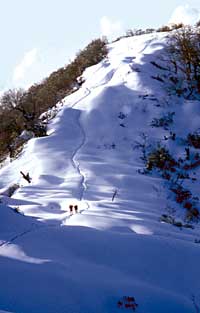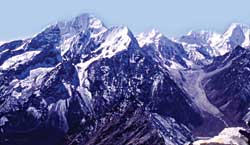 Alone porter ferries egg crates stacked several feet high. An occasional trekking group shuffles by. It is quiet along the Langtang trail this season, the closest really wild trekking area to Kathmandu.
Alone porter ferries egg crates stacked several feet high. An occasional trekking group shuffles by. It is quiet along the Langtang trail this season, the closest really wild trekking area to Kathmandu. Foot traffic in Langtang has slowed by half in the last few years because of fears of violence along the Trisuli Valley, but up here in the national park itself you are back in that timeless Nepal of the old days. A serene and silent land of sky and snow.
Right now is the best time to be in Langtang, the hills red and white with rhododenron. Most of the snow is gone and the days are warm.
It is still easy to get to Langtang. Public buses leave daily for Dhunche along the bone-rattling 7-8 hour bus ride to Syabru Besi. Private jeeps can also be hired for $100. The road is gravel, and was completely washed off near Ramche in a huge landslide last monsoon. Once in Dhunche, guides and porters are readily available and the lodgeowners are happy to arrange them for you. It's a gradual climb, so if you pack wisely, you can carry your own backpack. There are enough lodges along the way, and there is no need to carry tents.
Langtang National Park is home to 250 bird species and 32 species of mammals including wild dogs, thar, ghorals, serows, musk deer, red pandas, black bears and snow leopards. The reason for this diversity is that the terrain rises vertically from subtropical slopes above the Trisuli to alpine along the Langtang Khola right up to arctic along the moraines of the Langtang Glacier.
To protect this spectacular biodiversity, while ensuring community development goes hand in hand with the sustainable use of forest resources, this 1,710 sq km area directly north of Kathmandu Valley was designated a national park in 1976. Park warden Megh Bahadur Pandey in Dhunche feels the level of people's participation in conservation efforts is encouraging. The 34 villages within the park plan and manage local conservation themselves through forest user groups and committees.
"Before, the army used to look after the national park. Now we look after it ourselves," says Chiring Phincho Tamang, who is the chairperson of the local forest user group in Syabru. He is cutting pipes the for drinking water taps the community is building as he talks to us. Villagers can only collect dried branches and fallen trees for firewood and only cut trees for timber with a national park permit. Wildlife populations have increased, he adds, and some like the wild boar and langur have gone out of control.
"If we save the forests now, our children and grandchildren will have them too. And tourists will come," says Dorje Namgyal, secretary of the user group. But there are still some serious challenges. Namgyal estimates only a third of villagers understand the importance of conservation. "They feel the laws are too strict. It's difficult for those with no money to buy timber to build houses."
 Still, Tamang and Namgyal feel these are issues they could resolve among themselves if only they were given more decision-making power. "If we were given full responsibility, there would be more conservation."
Still, Tamang and Namgyal feel these are issues they could resolve among themselves if only they were given more decision-making power. "If we were given full responsibility, there would be more conservation." After a year-and-a-half as park warden, Pandey thinks the ultimate challenge is poverty. "People depend on the forest for their livelihood, their immediate needs and demands," he says. "Survival is still bigger than conservation."
The park has 54,000 inhabitants within a 420sq km buffer zone established in 1998. Higher up on the trail there is no electricity, and this puts a strain on the forest since firewood is still the primary means for cooking.
In Langtang village itself, Karma Tamang's Eco Guest House is lit by power from a microhydro plant down the hill. He has solar cells on his roof for backup. Passive solar panels heat water for the showers. Tamang has also devised a mixture of firewood and yak dung as an efficient fuel: the inside of the dung remaining hot like charcoal.
The reduction in the army's presence within the park boundaries hasn't meant an increase in Maoist activity, nor has there been an increase in poaching, according to game scout Bom Bahadur Shrestha in Ghode Tabela.
"If anything, poaching is a lot less since people don't walk with guns or even keep them at home for fear of being called Maoists. Security is in fact stricter," he tells us. From his post Shrestha continues to monitor use of forest resources, collecting timber permits and going on regular patrols.
Langtang has seen a sharp decrease in trekking traffic. Two years ago, 13,500 trekkers came here, last year just 6,000. This has impacted community develop-ment projects like education, health, road works and plantations which depend on tourism income for funds. Perhaps the fact that there are so few tourists in Langtang is in itself an added attraction for those who want to get away from the beaten track.


